Jim Shaughnessy
Railroad Photographer
1933 – 2018
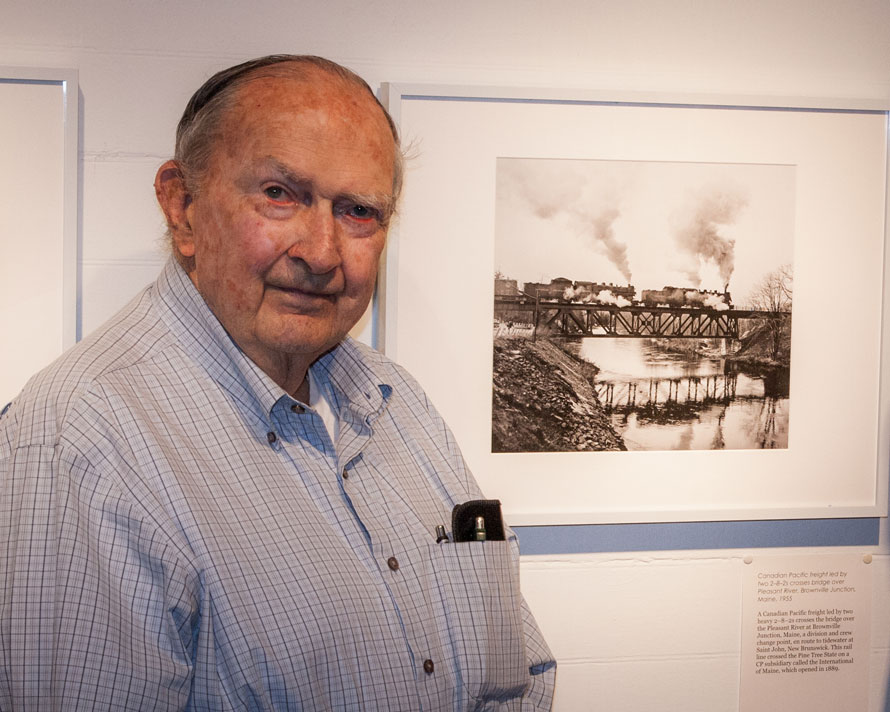
In 1959, a third grade boy borrowed a train book from the school library and sat down to enjoy it in the school cafeteria. Soon special pictures filled his imagination.
There was a nocturnal image of the 1852 train shed in St. Albans, Vermont, displaying a immense Central Vermont Mountain locomotive . . .
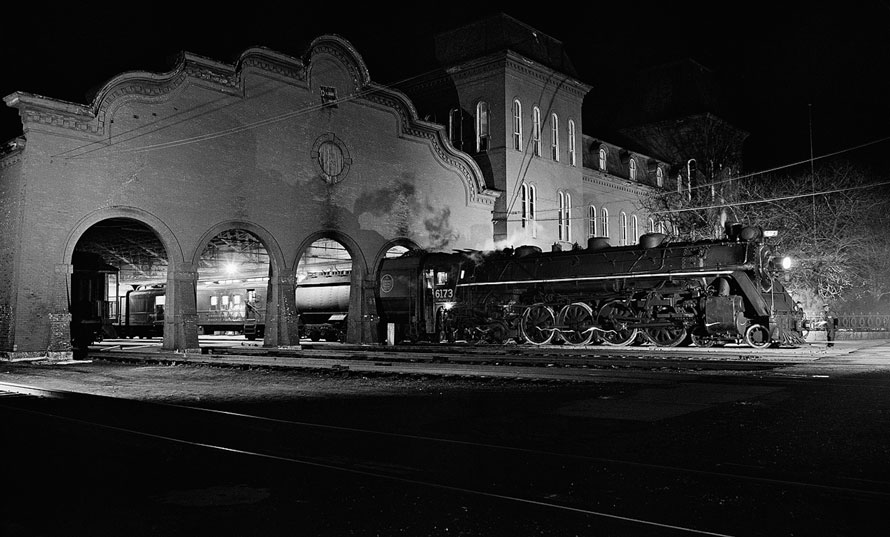
. . . and a going away shot of double-headed steam in Lennoxville, Quebec, blasting cumulonimbus clouds of frozen steam skyward . . .
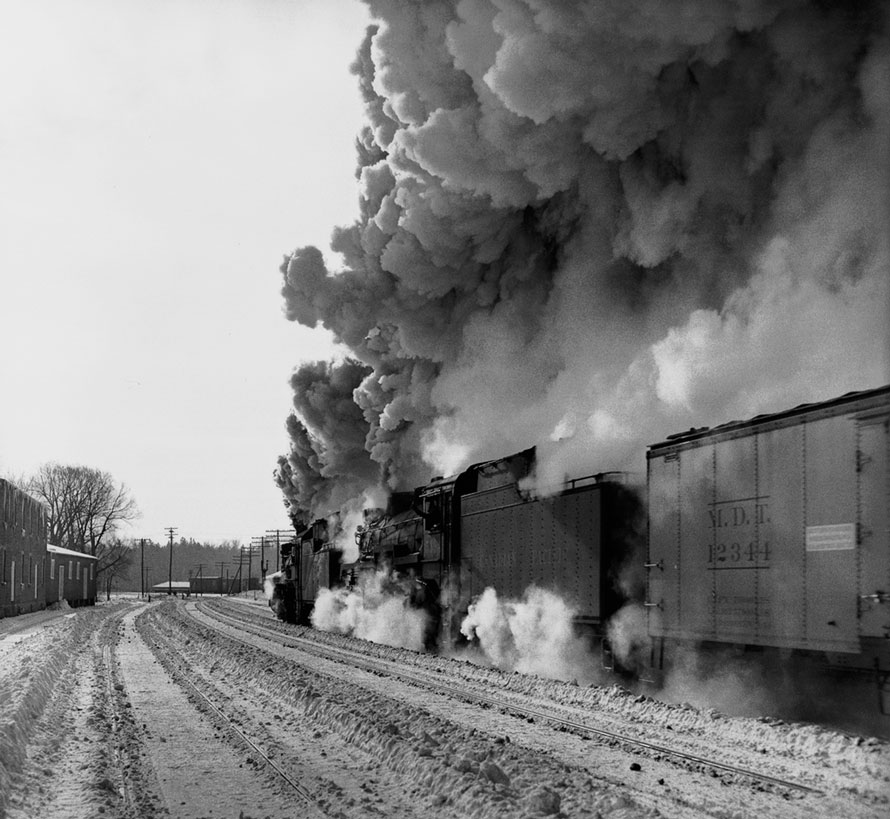
. . . and finally, there was an view of a Lima Pacific screaming her swan song on the mainline. (see Boston-&-Maine-4-6-2-#3713-Haverhill-Massacheusetts photo below)
We are most fortunate indeed that a photographer was present and each time his shutter clicked, a classic image was born.
Jim Shaughnessy, one of the giants of railroad photographers, took these photographs. Jim had few equals and no superiors. The 1950’s, the years of Jim’s most prodigious efforts, coincided with the traumatizing transition from the majestic steam locomotive to the efficient diesel-electric. During this time, thousands and thousands of photographs poured from his Speed Graphic and Rolleicord. These photographs created an oeuvre that will be admired for all ages.
Why was he important to railroading photography? It is not as though railroads had ever lacked photographers; the rail industry and photography were born within years of each other and they grew up together and were inseparable. In time, innumerable photographs were made of this great mechanism that could transport goods, services and people in a manner that gave the United States the power not only to settle its huge land mass, but the power to become a world leader.
Early photographers such as William Henry Jackson and Fred Jukes showed the land, the cities, the industries, the people, all caught up in the grand sweep that was the railroad and the nation.
I have long pondered why Jim’s photographs are so good, so successful.
However, in the 1930’s came the rise of the railroad enthusiast and their concentration solely on locomotive photography. As exemplified by the photographs and books by Lucius Beebe, the perfect railroad photograph, a three-quarter angle “wedge-of-pie” or “wedgie,” excluded almost everything but the locomotive and its train.
Fortunately, this nascent railfan photography period, with its rigid formulae, was brief and began to disintegrate in the post World War II period. I believe that it did so because after mastering the railroad wedgie, leaders in rail enthusiast photography matured as photographers and wanted to go beyond it. Jim, who started his serious efforts as a teenager in 1948, made it his own quest to do the same. In effect, these leaders rose to the level that professional photographers had all along. Jim however, took his railroad photographs beyond mere professionalism. He did so by making his exemplary.
I have long pondered why Jim’s photographs are so good, so successful. How was it possible that he was able to craft images that had such resonance, emotion, power and beauty?
I do not think anyone would disagree with my saying that the secret was in his outstanding grasp of composition. I feel this was the key to his success. If we think of composition as the arrangement of elements within the frame of a work of art, we can then begin to see how he constructed his images.
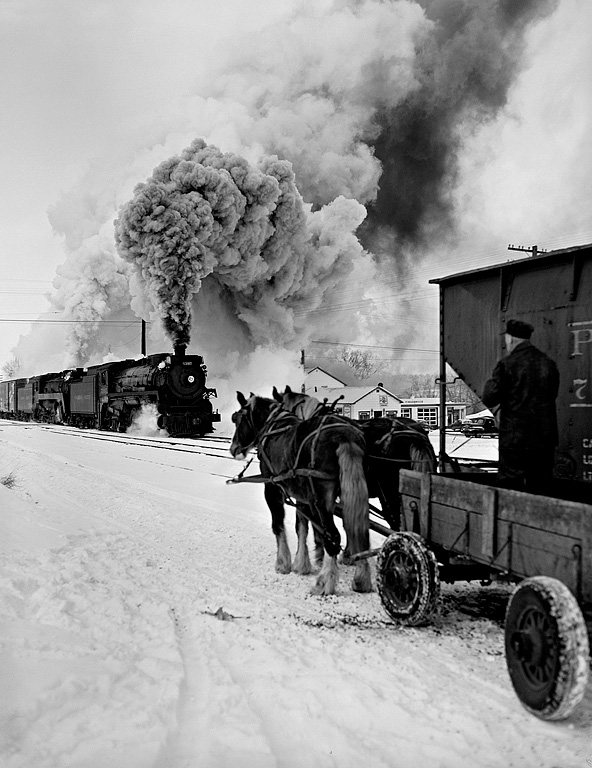
Let’s take for example one of Jim’s personal favorite photos, the one titled “Canadian Pacific, Cookshire, Quebec, 1956.” (A photograph he took when he was a mere 23 years of age mind you.) This scene is in winter and has a Canadian Pacific Railway steam locomotive double-header facing off against a farmer with his two-horse wagon alongside a railroad hopper car. I think it safe to say that anyone who was able to incorporate all these elements into a single frame would have a winning photo. But what makes Jim’s image so special? Here Jim’s ability to see what frame would work best came into play. His eye told him to come round in back of the wagon, to make it, the farmer, the horses, and the hopper all elements that would create leading lines pointing directly to the fire breathing monsters billowing their magnificent smoke plumes. While our eyes ride over the all the main elements in quick succession, each one powerful in their own right, we become connected to the scene. This ability to emotionally connect the viewer with the image was Jim’s gift.
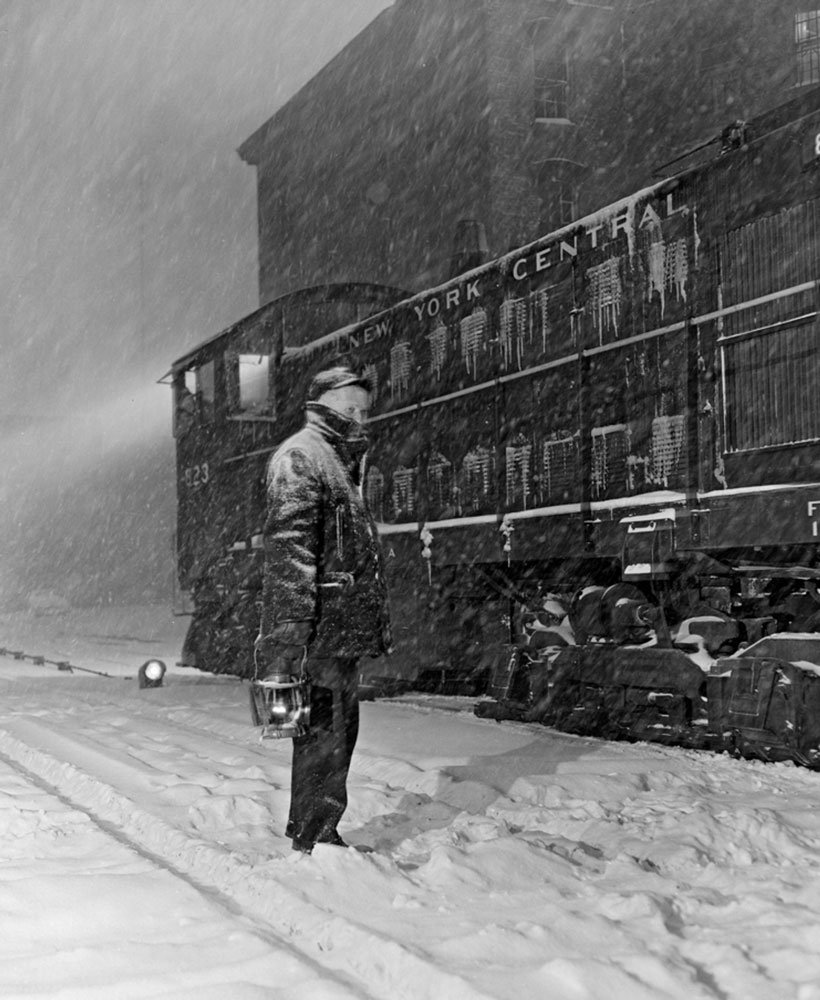
I know that Jim would be the first to scoff at this assessment. How do I know? He told me in person when I had the great fortune to meet him. He said, “Some people go too far about this stuff. Really! Would you pay 30 million for a Picasso?”
This statement I recognized because this is what other great photographers of Jim’s generation that I have met or worked with have said as well. Gracious men of his era sloughed off such pretensions, and they, as well as Jim, would feel that they were really just craftsmen and not artists, with or without a capital A.
OK, but can you say how you created your photographs?
He said (and he it said it all with this one line) “I photographed what I saw.”
I have found that wisdom, in its purest form like that of Jim’s above, is completely inscrutable the first time you hear it. It makes no sense or elicits a “That’s no answer!” What is not known is that you must discover the same truth in your own way and time. Only then will it make sense and resonate in you. What Jim said did resonate with me for I had, in my own way, discovered that “I photographed what I saw.” For me, this was an unexpected connection with one of the greatest photographers I had ever known, one that I never thought would occur. It was an incredible moment for me and I shall never forget it.
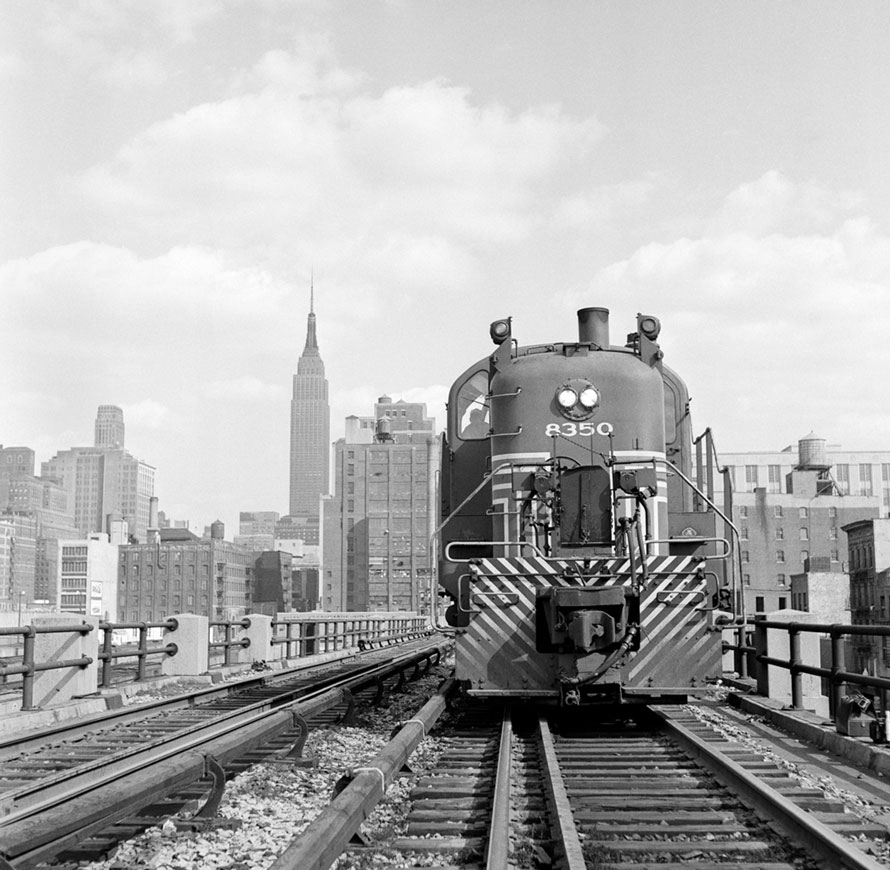
In my vocation and avocation, (both centered around cameras) I have pondered what does it take to become a leader in any profession. For me, it comes down to just two things: talent and personal interaction.
We have seen that Jim possessed the talent and that he was recognized for it in the popular acclaim for his thousands of photos in magazines and books, including his own The Rutland Road (1964) and Delaware & Hudson. (1982) His talent was further certified when he received the Lifetime Achievement Award for Photography from the Railway & Locomotive Historical Society in 1987. However, there is a very important factor that is essential, and that is making sure others know what you are doing. Here is where Jim’s other talent, personal interaction, came into play.
Jim was a superb salesman and promoter of his work. He had a tremendous drive not only to shoot but also to share. Not unlike today, where everyone is into sharing, Jim did it in pre-internet fashion by making sure he got his prints out there. In order to get this exposure, he cultivated a relationship with a certain magazine editor. That editor, the one heading the leading railroad enthusiast periodical Trains Magazine, was David P. Morgan. All of you of a certain age know precisely who that is. Morgan, bar none, was the Babe Ruth of railroad magazine editors. Like Jim, he was young and in his twenties, and his leadership at the magazine brought freshness and excitement to a transportation industry periodical heretofore unseen. Morgan, dealing with the ramifications of Trains Magazine’s declining readership which was inexorably coupled to the decline of the steam locomotive, needed fresh-eyed photography to keep reader eye-balls glued to his pages. Therefore, Morgan championed new, fresh idea photography in spite of old guard grumbling. Because of Morgan, Jim, along with his contemporaries, had an in with the most important vehicle for sharing their work.
Being in the magazine gave Jim great exposure to the movers and shakers in the railroad avocation. It would be a safe bet to say that probably the first time the magisterial (and powerhouse) railroad photographer and author Lucius Beebe came to know Jim’s byline was from Trains Magazine. By the late 1950’s, Jim’s work was enjoying big splashes in books by Lucius and his partner Charles Clegg. Their book, “The Age of Steam,” was a particular showcase for Jim’s work. I would say that must have been pretty heady stuff for him, a man not yet out of his 20’s.
I think lots of times when we look at pictures, whatever kind, we should stop and think that this is only a beginning.
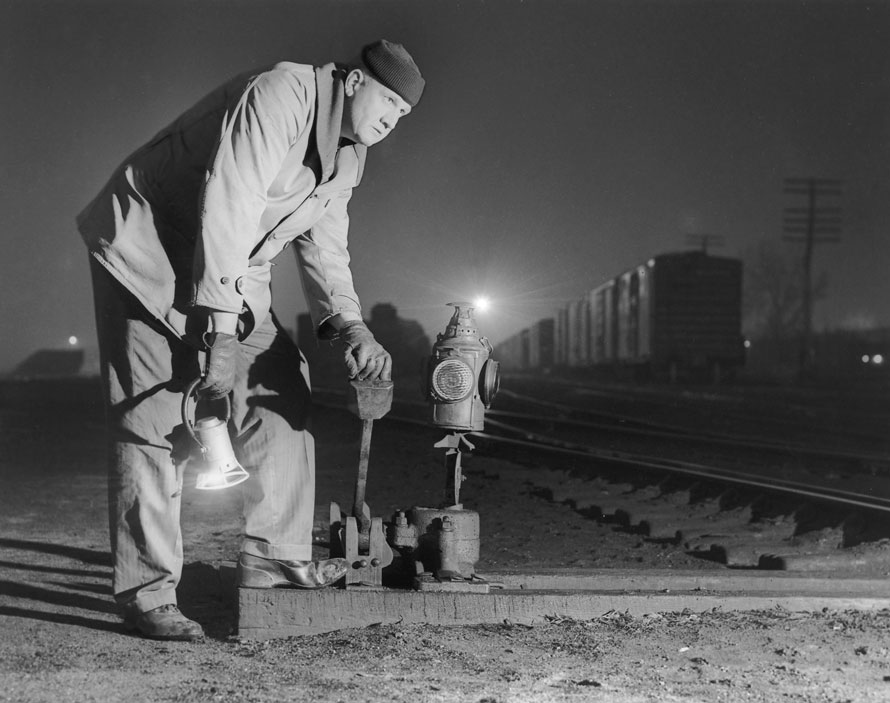
Jim said to me, “I was very lucky that I was promoted. There were other guys as good as me but they didn’t get the promotion.”
Indeed, I can think of several photographers of the time who had very good work but whose names are largely forgotten now.
Certainly, he was promoted by the titans Morgan and Beebe but in the end, it was Jim himself that sealed the deal on his fame. That is because Jim’s work was available to anyone. Just ask him for some prints, and they would be at your door in days. Not only that, the prints were beautiful and publish-ready with copious captions and historical detail. He did this for anyone; no favor was too big or too small. In this way, Jim’s work was everywhere and everyone knew his name. Publishers were thrilled to have great images and grateful to Jim for solving their problems. He did this right into his 80‘s. Rob McGonigal, the editor of Classic Trains Magazine always had a solid article whenever he got another installment of “The Shaughnessy Files.” In fact, an installment appeared in the magazine’s Winter 2017 issue just months before Jim’s passing.
While Jim’s fame was assured, there was something missing. What would that be? For many of the railroad photography cognoscenti, the issue was that while Jim’s work was everywhere, it was also nowhere. That is because in all these decades, no book existed that focused on Jim’s work as a photographer. In all the books, including Jim’s own, his photos were only in the context of the subject and not his photography.
One team, one that was arguably the best suited for the task, recognized that this was a situation in need of correction. Jeff Brouws and Wendy Burton together have produced five books on railroad photography, championing the photographer in each. Regarding Jim’s work, Jeff felt an artistic review and celebration was long overdue. As life would have it, about twenty years ago, the two became friends and in time, a book was begun. Working with Jim, Jeff viewed over 60,000 negatives (by hand!) and in time winnowed it down to the 143 selected for the book. At this point, Wendy applied her discerning eye to sequencing the photographs, creating a path that flows from one amazing image to another. Jeff, as the books designer, applied his superb taste to the page layout and graphic design. Finally, in The Call of Trains, Railroad Photographs by Jim Shaughnessy (2008) Jim had a book that was equal to his work.
“Yes, I made mistakes. I would have had some really great shots if I could only figure out to print dark slides.”
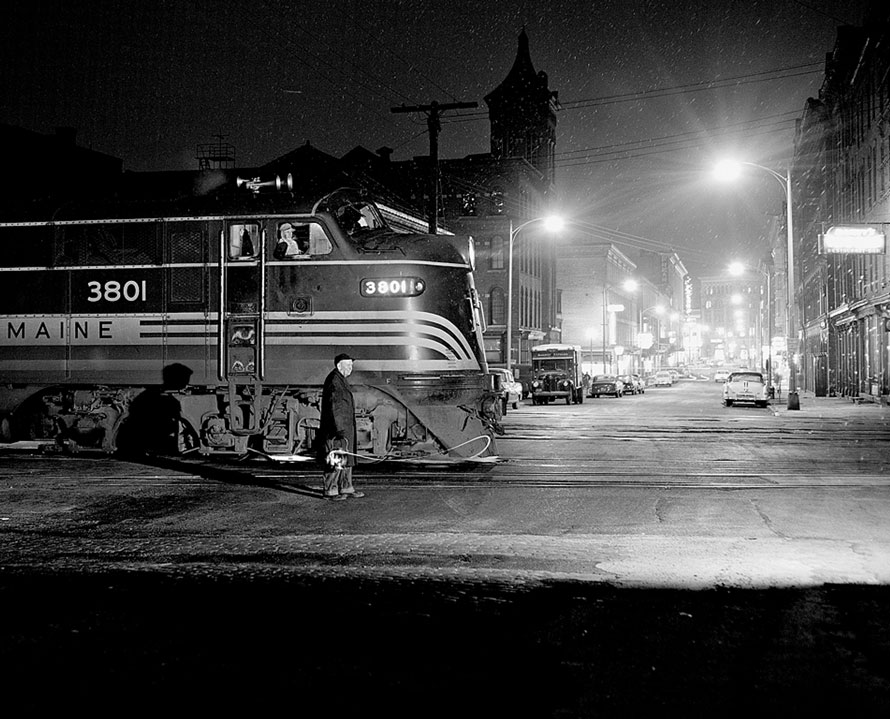
But it didn’t end there. Some years later, Jeff came upon the banker’s box that held all the images that had not made the cut for the first book. Looking with fresh eyes, he got excited all over again and saw that there was more than enough to justify a second volume, Jim Shaughnessy, Essential Witness. With an introduction of great clarity and taste by Kevin Keefe, past editor and publisher of Trains Magazine, the book was published in 2017, ten months before Jim’s passing.
Earlier, it was mentioned that Jim’s talent for photography and for marketing was the reason he became one of the leaders in this very narrow field of artistry. I want to add one more reason. Because his superb work was seen and seen so often, his best images became iconic. For any photographer to make one iconic image is most fortunate. However, with Jim’s tremendous oeuvre, he had several. That is the magic; that is why his work will stand the test of time.
I think it is now time to let Jim do the talking and let his humility and great sense of humor shine through.
Many photographers will identify with the knowledge that, yes, even Jim Shaughnessy could be fallible. Jim’s Speed Graphic camera, a beast to master, required that the dark slide covering the film holder be pulled before the camera could take a picture. If this was not done . . .
“Yes, I made mistakes. I would have had some really great shots if I could only figure out to print dark slides.”
Here Jim speaks of two of his favorite shots.
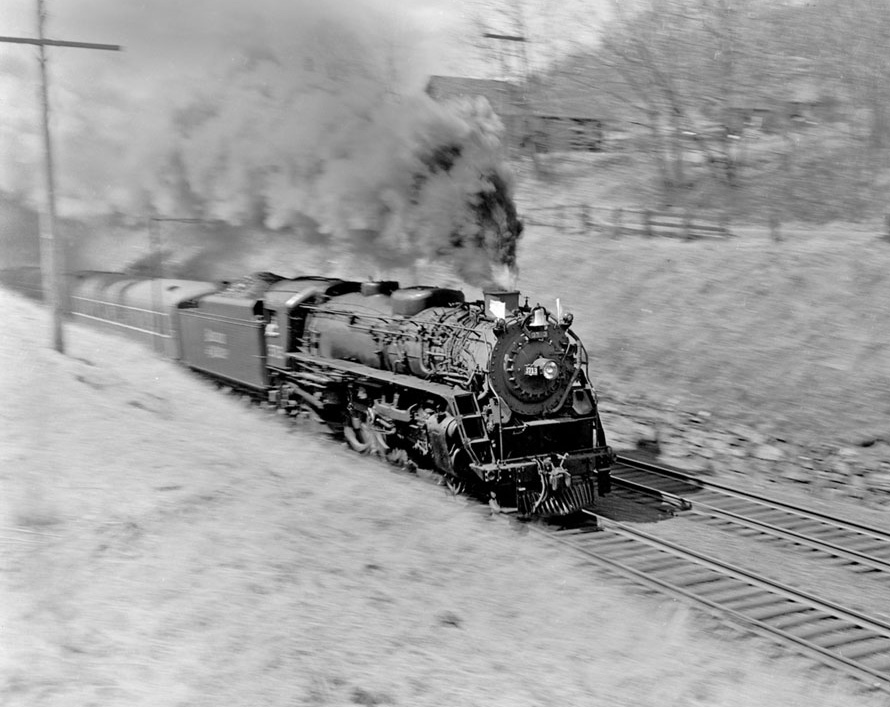
“This was my “Hail Mary” shot. I was with a friend of mine and we were chasing the last steam locomotive train on the B&M. It was run from Boston to Portland, Maine. We were chasing it along but it was catching up to us. We stopped where there was an overpass bridge. I looked at the location, it was backlit, it was nothing. So I ran around to the spot where I took the photo, below the bridge in the distance. By the time I got in position, the train was on me. I set the aperture at f8 or f11 or whatever, then set the focus at just short of infinity. I put the shutter on a 1/25th of a second and I then moved the camera along as he sped by. Afterwards, I brushed the cinders from my hair and unlike today where I could look at the back of the camera, I had to wait until I got home.
“I was with my friend Phil Hastings that day. He said, ‘I have a medical convention in Chicago and I am going to have lunch with Morgan in Milwaukee. Why don’t you give me some of your prints?’ So I did. Then four-five weeks later with the next issue of Trains, I got the centerfold with this shot of No. 3713 and Hastings got nothing.”
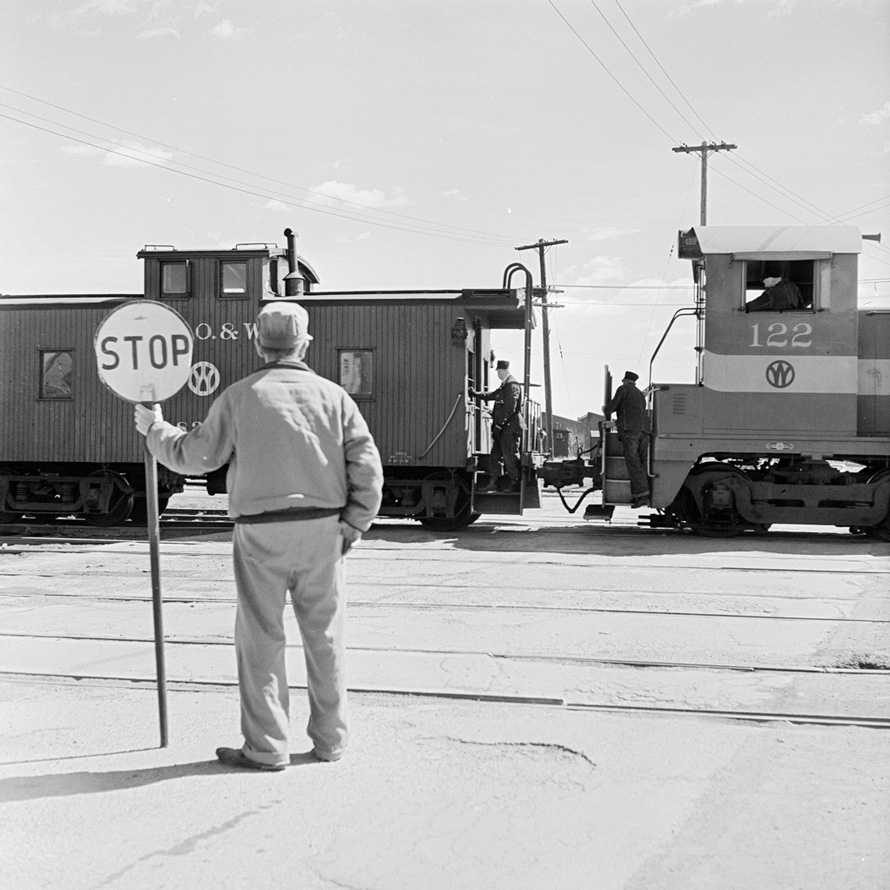
“I always like to have people in the picture. Because to me, as long as they were not posed hokey, I wanted to show activity that was actually going on.
“I find that when you are looking at this type of picture with people in them, if you are good, you can shut your eyes and imagine what was going on otherwise. Even though this guy with the stop sign is standing still, you know when the train gets over the crossing, he’ll put the sign under his arm and go back into his shanty. This I find is a way to try to get emotion, lets say mental impressions, of what is going to happen in a still picture. And I think lots of times when we look at pictures, whatever kind, we should stop and think that this is only a beginning. We can imagine the rest of the operation that is being pictured. And in that way we can kind of move into the view ourselves and get the rest of the story.”
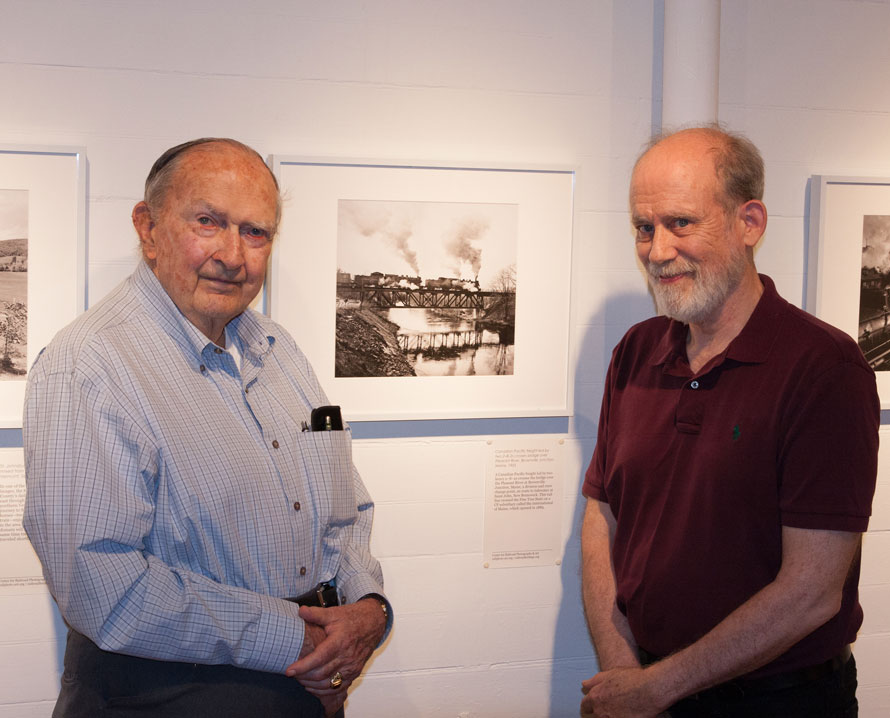
As that third grade boy who looked at The Age Of Steam so long ago and is now all grown up, I continue to get the rest of the story of a special time and its people though the eyes of Jim Shaughnessy. All of us hereafter are the lucky ones because Jim photographed what he saw.
Dennis Livesey – Text Copyright 2018
Photos used with the permission of the Shaughnessy Family. Jim Shaughnessy's family has designated the Center for Railroad Photography & Art for memorial gifts which will help with the digitization of his collection. For more information, visit http://www.railphoto-art.org/collections/shaughnessy/
Hi Dennis:
Have been doing and will be doing some railroad adventures. In June I took some friends to the Brighton Beach Station to ride four sets of vintage subway and el cars. In July while on a cruise we docked in Portland, ME and saw the narrow gauge steam engine when it pulled up next to where our ship was docked for the day. Yesterday we went with our bus tour group first for lunch at the C.I.A. in Hyde Park and then to the Walkway Over The Hudson. We had four guides with our group who talked about the history of the bridge. I did some talking about what I know about the bridge when it was needed to add or correct what they were saying. I mentioned that I have two friends who ran trains on it. This got me thinking, if you would like to get a lot history about railroading in the Hudson Valley we should get together with George Kowanski. I have known George for since the late seventies. He has a lot of knowledge of railroading and other history of the area. He worked for Penn-Central and Metro-North for around forty years. He always has a lot to say on these subjects. Also some of the others who also worked in railroading that I have known a long time can talked about the history and their experiences with railroads. Next month we again with our bus tour group are going to Essex, CT first for lunch at The Griswald Inn there and then ride the Valley Railroad and boat ride. Hope to hear back from you soon.
Ed,
Thank you for the update.
Dennis
What a great tribute to a great photographer. Thank you, Dennis, for sharing your thoughts on Jim’s work and its importance both then and now. He certainly had an eye for composition.
It’s interesting to see what photos you selected to show in your article. Every great photographer has a style. To me, the signature Shaugnessy photo is taken from trackside, behind the engineer, looking forward “over the engineer’s shoulder”… yet nothing like that is in this tribute. It really shows the depth and breadth of Jim’s contributions.
Traingeek,
I picked two that were very personal and the rest I tried to balance between night and day, steam and diesel and Jim’s most iconic shots.
Thank you for your kind words, I am so thankful to The Trackside Photographer for the opportunity.
Dennis
A wonderful article Dennis. Just terrific.
Thank you for the very kind words.
It was something I very much wanted to do.
Dennis
A great man who will be missed.
Jbcowgill,
Those are the feelings of many. Thankfully, Jim left a great legacy that will be enjoyed for all time.
Dennis
Dennis,
A great tribute to a true legend and pioneer of railroad photography.
“I photographed what I saw” is a statement on vision. That he had vision and a way of seeing positions him as an artist. You are an artist as well – and that’s the real connection!
The ironic thing about his reputed favorite image, B&M 3713 at Haverhill, is that it is a most conventional image and one that would easily fit the label of “wedgie”. His images are extraordinary due to his excellent compositions and this is not one of them. No doubt this was a favorite due to the experience and memory it created for him though. We’re all guilty of that!
Eric
http://www.ericwilliams.photography
Eric,
Thank you very much for the very kind words. Really, it was the fact that Jim had such an influence on us for so many years, I just had to say what I felt.
The No. 3713 shot is indeed a wedgie in its basic form. However, what takes the photograph out of that realm is the utter perfection in the execution of the pan. Because only the very front of the boiler is in focus, the shot is taken from the prosaic to the transcendental. This has made it Jim’s most popular image and it has become his signature. Artist’s don’t get to pick that, the public does.
Yes, other images of his have more technical artistry but none have greater emotional pull.
Dennis
Eric and Dennis,
It is most interesting to hear different takes on this. I lean a bit towards Eric’s point of view–#3713 is not among my favorite Shaughnessy images, but I can see the emotional appeal of it. One of the lasting strengths of this body of work, in my opinion, is that these photographs have the ability to speak to so many different people in so many different ways. In a world where millions of cookie-cutter images are produced every day, Shaughnessy’s vision refreshes and inspires.
Edd
Dennis,
I couldn’t agree more that the “public” picks an artist’s signature image.
However, I have never heard anyone refer to this particular image in that way and I would pick others to be considered among his signature images. To me, his best images are grounded in intent, reflective of his wonderful vision. This one is more a lucky accident, which he acknowledges himself. It’s a fine image, but not particularly skillful and to me doesn’t have his signature vision.
Eric
No. 3713 is one of Jim’s personal favorites and has appeared in books and magazines for decades and is closely associated with him. It was even a print offered by CRPA. So maybe you never heard before but I am saying it now, it is Jim’s signature work. By that I don’t mean it is his best, nor what rail photography aficionados would say is his best; what I am saying it is his most popular, the one most coupled with Jim and his wider, public audience.
Is “Hot Shot Eastbound” Link’s best? Is “The Mohawk That Refused to Abdicate” Hastings’s best? Is “Milauwkee Road, moonlight portrait of Little Joe #E77, near Avery, Idaho, 1973” Steinheimer’s best? You could argue no in all cases.
But those are the ones they are most famous for.
Great Article Dennis. I always connect him with Troy but one heck of a back story to go with a great photo.
A great article! He had the “eye” for photography!
Hi Dennis:
I saw your name in the credits for the movie “Bad Lieutenant” from 1992.